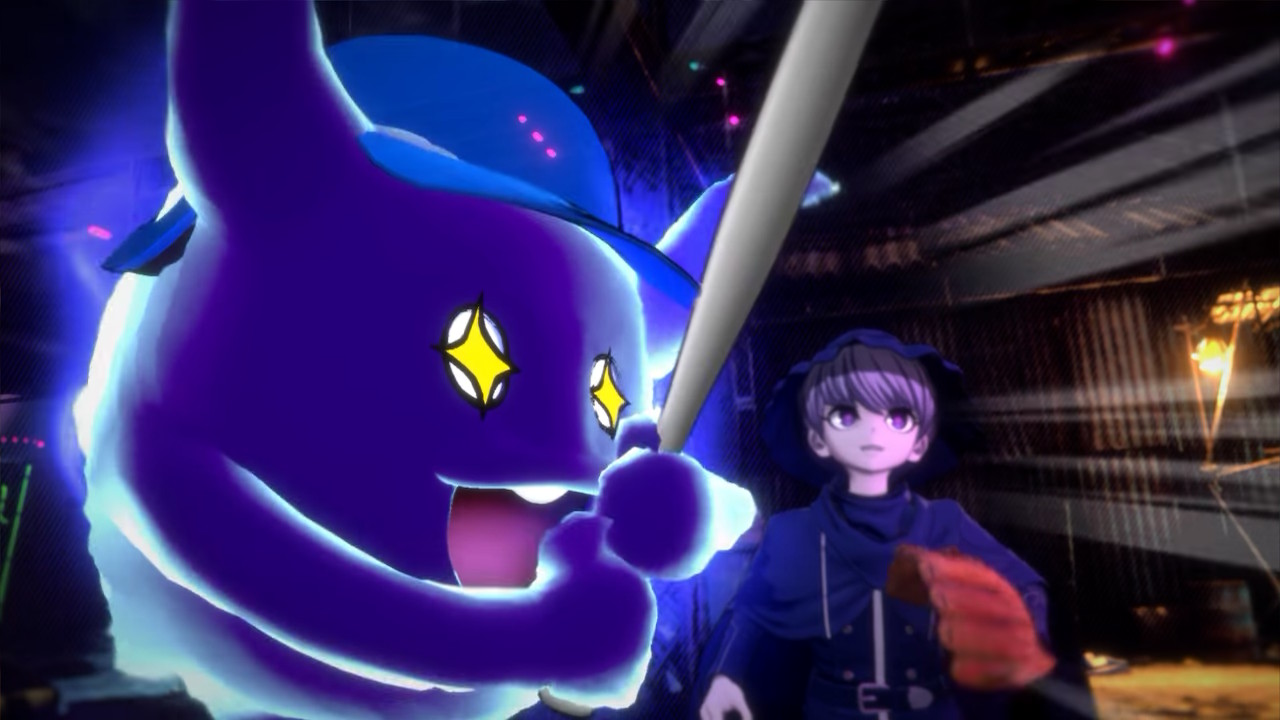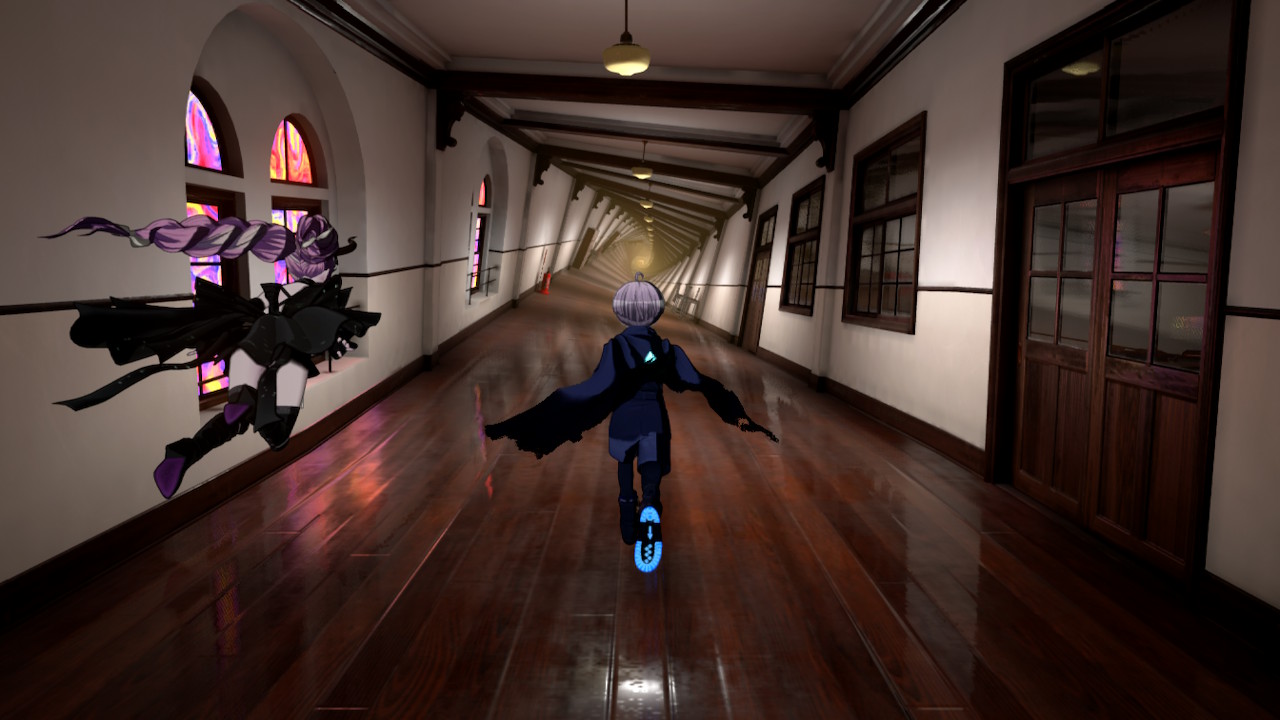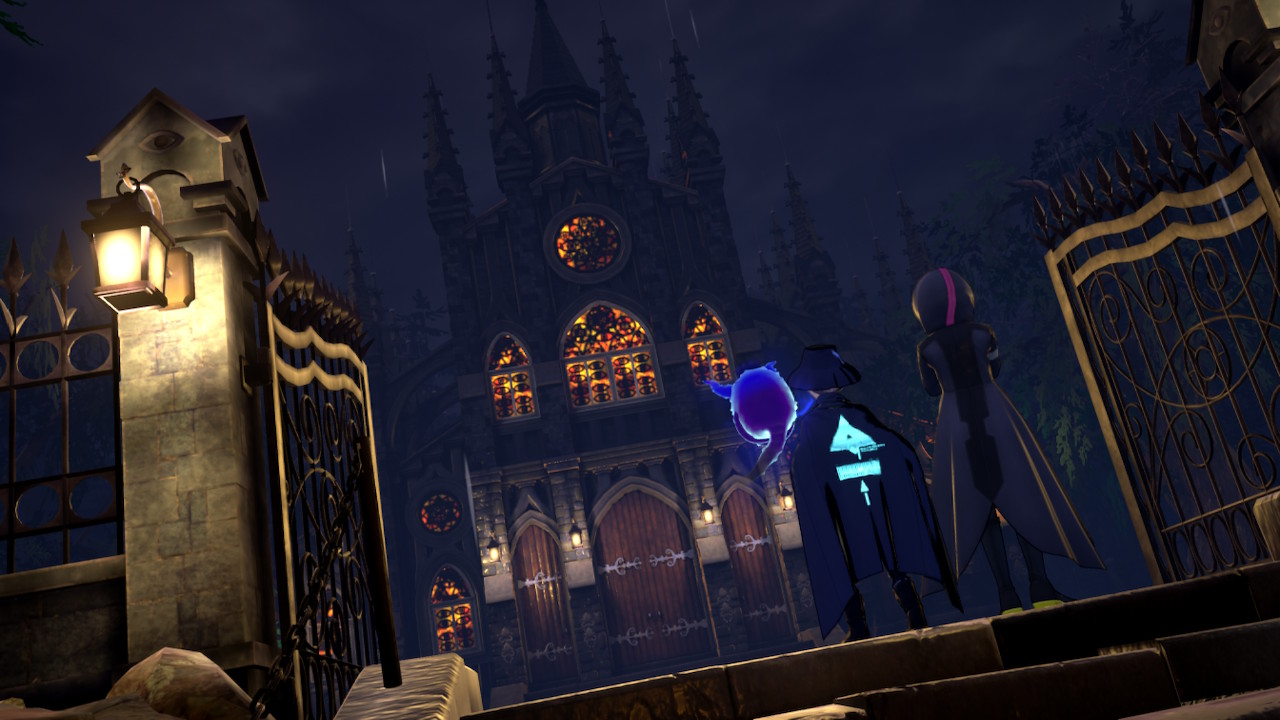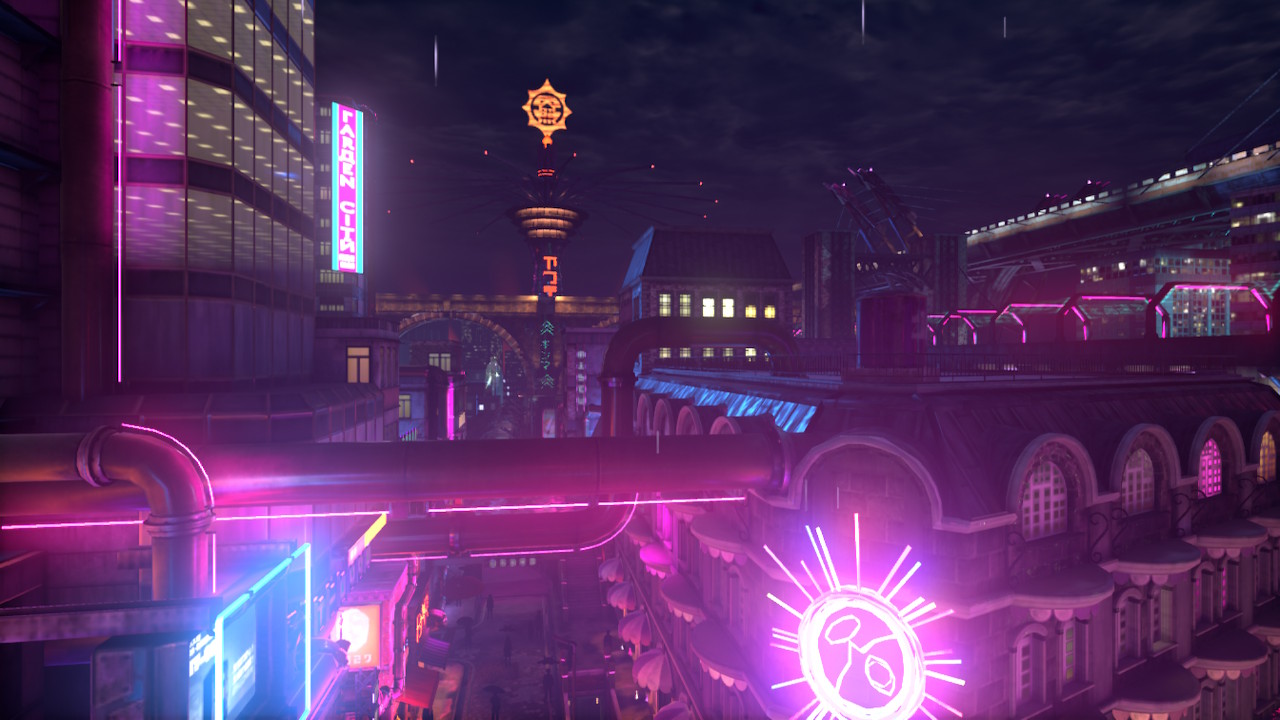Master Detective Archives: Rain Code is a game that has been on my watchlist since its announcement in 2021. Knowing it was made with several key staff from the Danganronpa series, including creator/writer Kazutaka Kodaka, I was sure it would be right up my alley. Now, having beaten it, I can safely say I was right. However, it ended up so similar to Danganronpa in so many ways that it’s impossible to talk about without making heavy comparisons to its spiritual predecessor.
A Dynamic Duo
The biggest departure Rain Code makes from its forebearer is that it’s no longer a killing game scenario. You play as Yuma Kokohead, a trainee detective tasked by the World Detective Organization with going to the isolated city of Kanai Ward to solve its greatest mystery. Kanai Ward holds many secrets and is under the control of Amaterasu Corporation, a Shinra-esque company that is clearly up to no good. Yuma is also an amnesiac due to making a pact with a Death God named Shinigami. The details of this pact can’t be shared with Yuma, as disclosing its terms would break it. It’s a solid central mystery that kept me guessing throughout the story.
Shinigami is Rain Code’s mascot character, a cute little ghost that has some playful banter throughout with Yuma. The pair have some excellent dynamics, and by the game’s end, I had grown very fond of them both. It is worth mentioning that Shinigami also has a human form whose design is laser targeted at a particular subset of people online. The entire game is littered with fanservice, and Shinigami is at the centre of most of it, even down to specific gameplay mechanics that I’ll get into a little later.

Upon arrival at Kanai Ward, Yuma meets with the detectives of the Nocturnal Detective Agency, introducing us to the main cast that joins him throughout Rain Code’s plot. They’re a solid group, each a familiar archetype. I didn’t gravitate to any of them at first, which left me a bit disappointed. However, the plot pairs you with one of them per case, letting you get to know them better. This one-to-one time with them did a lot of good, and by the end of the game, I cared for them more than I expected to.
During gameplay, you can find collectable Memory Shards that will give you further little interactions between Yuma and the cast. They’re not particularly difficult to find, with the game even giving you a menu with clues on their locations, and they offer up some extra character moments if you seek them out.
Not including the prologue and epilogue, Rain Code features 6 cases to solve, each taking 3-6 hours depending on your reading speed or how much you interact with optional points in the environment. I thought the cases were all enjoyable, with the final two being excellent. There is a bit of a lull in the 4th case, and the game has the familiar problem of the player figuring things out a fair bit quicker than the characters in-game. I managed to figure out some core elements of the game’s final mystery by the game’s third chapter because, much like the Danganronpa or Ace Attorney series, the writers can’t help but sprinkle in a bit too many hints early on. That’s not to say there are no surprises, however. There were several points in the game where the game had messed with my preconceptions of some of its grander elements, and the strength of those last two cases retrospectively elevated the previous ones.
By Rain Code’s end, I felt it did enough to establish itself as a new franchise that can shake off the shadow of Danganronpa that so aggressively clung to it. I can see a Master Detective Archive franchise that can do away with the more complicated overarching story that Danganronpa had spread across several games, anime and novels; and instead focuses on one-shot mysteries with the same recurring cast of characters.
If It Ain’t Broke…
When it comes to the Rain Code’s gameplay, anyone who has played the Danganronpa series will notice that it plays almost identically. Several of its puzzle mechanics have been lifted and placed into Rain Code with minor tweaks.
The most Rain Code does to set itself apart is with Mystery Labyrinths. Once you’ve uncovered enough clues by investigating scenes related to each case, Shinigami can use her ability to open up a Mystery Labyrinth. These are separate dimensions that Yuma can explore to uncover its hidden truths. They’re manifestations of real-world crimes, and once Yuma can piece together the solution, he can find the true culprit. This comes with a cost, however; one that asks some interesting questions about what a detective is and leaves Yuma to think about if his search for the truth in these cases is worth the cost his deductions have.

The Mystery Labyrinths aren’t labyrinths, more like straight corridors of exposition between various puzzle elements. The most labyrinthine they get is giving you the occasional fork in the road where you’ll have to pick the right path to proceed. The presentation of these corridors is excellent, pulling off some cool visuals tied to the case you’re solving.
As I mentioned, the puzzles you’ll encounter in the Labyrinths are typically taken from Danganronpa. The Reasoning Death Match is Rain Code’s equivalent of Danganronpa’s Non-Stop Debates: Yuma will have statements thrown at him by the Labyrinth’s Mystery Phantom (a manifestation of the cases culprit or someone hiding the truth) and will use clues found in the investigation to find contradictions in it and break them open with his Solution Blade.
There are also Shinigami Puzzles, Rain Codes version of Hangman’s Gambit, in which Shinigami will be stood in a barrel while you try and pick out the correct letters to make up a word that will help find a solution to a part of the case. These are the gameplay element I previously mentioned regarding Shinigami and fan service. She’s in a bikini, and once you’ve solved the puzzle, she’ll strike a pose that the game will hold on for a little too long as a little “reward” for solving it.
I didn’t find any of the puzzles particularly difficult, and the game is incredibly lenient on you should you pick the wrong answers. You’ll be given clues to guide you to the solution should you get a puzzle wrong, and Yuma has enough stamina to last through tons of mistakes. It’s incredibly linear; you can’t miss any clues, so you can always move the story forward. It’s not too much of an issue, as I think the game is more interested in telling compelling stories than being challenging.
The last mechanic Rain Code lifts from Danganronpa is the Detective Denouement, its version of the Closing Argument. This is one mechanic I wish had been left behind. Once you’ve solved the case, you’re presented with a set of comic book pages that recount the mystery, and you must fill in blank panels to piece the whole thing together. This on its own is fine; easy, but a nice little wrap-up. The problem is that once you’re done, you’re presented with an unskippable cutscene of Yuma and Shinigami discussing every step. This has always felt pointless to me. I understand it’s so they can tell the culprit what they found to prove their case, but when I’m forced to sit through a bunch of cutscenes that border close to the 10-minute mark at the end of every Mystery Labyrinth, it feels like wasted time. I know all this information; the cutscene isn’t necessary. It’s the game telling the player information that they just proved they understand.

Besides its story cases, Rain Code has several optional requests for you to solve. These are locked to their specific chapters, but the game does warn you that you’re about to enter a point of no return, just in case you missed any. I’ll be honest; I only did the ones in the first two chapters they appeared in. They all felt like busy work that have you hopping around town to talk to the right NPC to then go to another place and find a different NPC. Maybe I missed out on some great world-building or character moments in the later optional content, but I was more invested in the overall narrative, and the game hadn’t shown me that the side requests were worth my time.
The only thing I’m sure I missed out on by not completing these side requests is some extra Detective Points (DP). Rain Code has a levelling-up system with various Detective Ranks. By completing mysteries, side requests, or just investigating interactable objects, you’re awarded DP. Levelling up gives you skill points to purchase and equip various skills. These skills grant benefits inside the Mystery Labyrinth, like removing incorrect letters from the Shinigami Puzzles or removing false statements in the Reasoning Death Match. Even without doing the side content, I had more than enough DP to give myself all the skills I needed.
While it might seem like I’m listing these constant similarities as potential negatives, I understand the reasoning behind implementing such similar mechanics. Keeping the Rain Code close to the Danganronpa formula allows for an easier transition into a new and untested IP that, if successful, can be used to springboard into its own franchise. I sincerely hope there is another Master Detective Archives title in the future, and it has the confidence to try some fresh mechanics.
A World that Pops
Rain Code’s setting, Kanai Ward, feels very unique. It’s a city where it has rained constantly, so its infrastructure has been altered to accommodate it. Drainage pipes are everywhere, the slums are more flooded, the upmarket areas are less cramped, and neon lights and rain-slicked surfaces make the world feel vibrant and alive. It’s not a particularly big map, starting small and opening up as you further the story, but its design makes it feel like a real lived-in place.

The soundtrack, by long-time Danganronpa composer Masafumi Takada, definitely keeps some of the DNA from that series’ score. However, it occasionally leans into more dramatic compositions that go with the detective theme of Rain Code’s story.
Rain Code allows you to choose from either Japanese or English voiceovers. I chose the English dub and felt the performances were solid across the board, with some being heightened during more serious and emotional moments.
Lots of Pace Breaking
One big bugbear for me in my time with Rain Code is the amount of loading screens it has you sit through. It could be that I’m just spoiled by the speeds of modern SSDs in the next-gen consoles, but having to sit through frequent loading screens that can take upwards of 30 seconds at times breaks up the pacing of more critical scenes. I’d estimate that probably more than an hour of my overall roughly 24-hour playtime was spent in loading screens.
Although it’s not a deal breaker, it is worth mentioning that Rain Code is another example of the Switch showing its age. In busy/complex scenes, the game’s framerate takes a noticeable hit.
Master Detective Archives: Rain Code is a strong, confident spiritual successor to the Danganronpa series. Whilst it might lean heavily on its forebearer for its mechanics, it tells a compelling story filled with likeable characters and tons of mystery.

Master Detective Archives: Rain Code is available now on Nintendo Switch
Developer: Too Kyo Games, Spike Chunsoft
Publisher: Spike Chunsoft
Disclaimer: In order to complete this review, we were provided with a promotional code from the publisher.
For our full review policy, please go here. If you enjoyed this article or any more of our content, please consider our Patreon
Make sure to follow Finger Guns on our social channels. Twitter, Facebook, Twitch, Spotify or Apple Podcasts – to keep up to date on our news, reviews and features.
